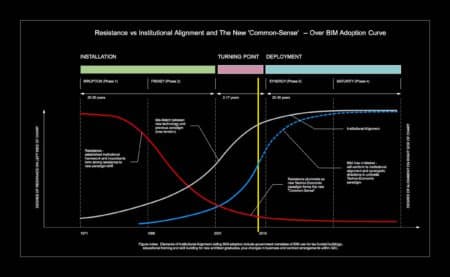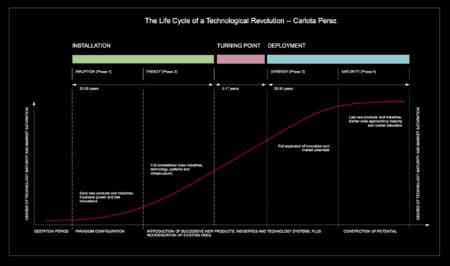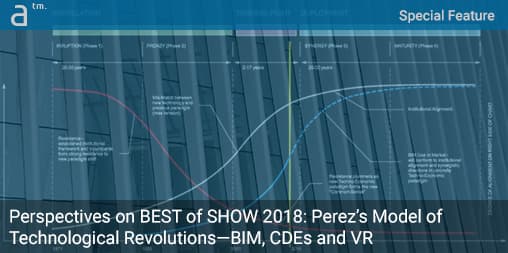Continued from page 2
Part 3: Towards a Smart Green Future—The Role of AEC
The Role of Alignment in Golden Ages
Perez’s model explains the inherent linkages of financial capital to technology in phases that lead to bubbles and golden ages. (We encourage the reader to view a video above for a fast primer.) In the fourth great surge (the 4th revolution: 1908 – 1971) the golden years emerged after the turning point of the Great Depression and WWII. As she says,
“During the golden age of Mass Production, in the 1950s and early 1960s, the interests of business and society converged. With the welfare state and suburbanization, working-class people in many Western countries could become homeowners and consumers. Therefore, when companies paid higher salaries and high taxes, it all contributed to increasing domestic demand. Government support for education and health services freed up discretionary cash for people to spend on consumer products.” (Perez)
In each of the past four great surges, the State and business effectively synergized a common direction after a sizeable financial crash in each surge. The coherence of direction—the “American suburban good life” model after WWII—coherently brought together a mature, industrial mass manufacturing model combined with cheap petroleum products, cheap steel, and a new infrastructure system every bit as transformational as canals and rail in their respective ages—the Interstate Highway System.

05 – In this chart, we overlay Carlota Perez’s theory model over the stages of BIM adoption thus far. BIM has faced resistance and institutional misalignment. BIM is a sub-paradigm within a larger paradigm that has not yet found its “common-sense” role in the golden age segments of the Information Age.
Perez notes that in the golden age of the 50s and 60s the key energies and materials of the era were cheap while labor was relatively expensive. Today we experience the opposite with wage stagnation and legacy energy economies which seek out higher costs. “Today, it’s energy and materials that are too expensive (or will become so if growth resumes strongly), and they need to be reduced to cut costs.” (Perez). Due to clear evidence of environmental damage, Perez adds, “Thus businesses are redesigning products for smaller carbon footprints, fewer materials, and zero waste.”
Perez advocates that in order for the next golden age to emerge society must align around a common vision of a smart green future. (again, her lecture on this is compelling)
The Next Golden Age: Perez’s Smart Green Future
For Perez, the natural path for the ICT (information and communication technologies) Revolution that emerged from Intel’s microprocessor in 1971, is for society to build a cool, smart, green lifestyle. But she questions if the new era “giants” will get us there.
“The new technology giants, like Google, Facebook, and Apple, along with others developing robotics and similar technologies, will comprise the high-productivity sectors. That’s understood. But they won’t lead us to a more decent society unless they encourage distribution.” (Perez). She insists that the new jobs come from lifestyle changes that support the new paradigm for society. A good example from the last era was the gas station owner and automobile mechanic, or the motel operator or fast-food chain manager. These were entirely new jobs created in the past great surge just as internet marketing is a brand new position today.
Perez insists that lacking a clear synergistic direction…the possibilities of using ICT in the direction of green is right in front of us. Such a new lifestyle change must be painted in aspirational terms and thus far the advocates for a smart green society have painted in a gloom-and-doom picture of environmental destruction instead. While her book was written just after the turn of the Millennium, much has transpired to sharpen her perspective on what the next golden age might look like. Here’s a key summary:
Carlota Perez’s Smart Green Future
The “accent” is placed on care, preventive health, exercise, and creativity and freedom. There is a shifting to services from products, making durable products really durable and moving towards a rental model in the economy (Uber for everything….) She says we need to print 3d parts as needed for fixing and renting.
— Smart Green Growth
— Human-Centered Services
— The Modernization of Production and Construction
Here are some technologies that are key to this vision:
- 3D printing
- Nanotech
- Sustainable Architecture
- New Construction Methods
- Bio-Plastics and New Custom Materials (think Neri Oxman)
- FTTH and wifi Infrastructures Everywhere
- Complex Systems Engineering
- Hydroponics and Urban Agriculture
Perez insists that the good life does not spread by fear or guilt…but by the good life. Each new paradigm shift must first be wrapped in the old. Recall that the first automobiles looked like horse-drawn carriages but with a motor attached; they were luxurious and aspirational. Here are aspects of her vision that are already underway:
- active creative prosumer vs passive consumer…
- fair trade and social responsibility…
- services vs tangible products…
- intense Internet use…
- working from home…
Every golden age has emerged from the country responsible for its technology revolution. But Perez sees the 4th and 5th great surges overlapping in a more time-intensive operation. “The American way of life defined prosperity for the 20th century…the European way of life can define prosperity for the 21st century,” she has said.

06 – In each great surge and technology-economic paradigm shift four key phases under two very different periods. They are Irruption, Frenzy, and then Synergy and Maturity after the “turning point.” Each phase has differing relationships between capital investment and technology with the Frenzy phase pushing innovation along at a very quick pace while the Synergy phase is characterized by aligning related sets of technologies around new common-sense ways of doing things.
Curve Fitting Hype Curve to Perez—Impacts on Tech
Perez does not talk about the Hype Cycle (as far as we have discovered). Nonetheless, we recognize that the Hype Cycle is not constrained to a notion of time itself—a set limited amount of years in which a given innovation matures and grows from edge-of-market to center-of-market. From Perez’s Techno-Economic Paradigm (TEP) model we understand that depending on where a specific technology is born within a given paradigm it will confront different forces of resistance and alignment inherent in four unique phases of Perez’ model. (see images 05 – 08)
Institutional resistance is the resistance to a new innovation when governments and learning institutions are pre-occupied with and aligned with a previous technology or set of related technologies. (see image 05 above which looks at BIM with regard to resistance and alignment) If a new innovation emerges during the SYNERGY phase and appears non-compatible with the prevailing paradigm, that innovation may face strong resistance. Business or firm resistance takes place when business owners and leaders hold onto their generation’s “common-sense” way of doing things. When firm titans find themselves led by “elder leaders” during the IRRUPTION or FRENZY phase of a new Techno-Economic Paradigm (TEP), such firms may plot themselves onto a course of slow demise as they fail to embrace the new innovations, and thus require a new generation of leaders who see the importance of the emerging Techno-Economic Paradigm shift.
Equally important to the trajectory of a new innovation is the role of financial capital during each of the four phases. In the first two (IRRUPTION and FRENZY) phases capital itself dislocates from production capital and seeks, initially, better sources of higher returns as previous paradigm technologies reach exhaustion. Once a full constellation of the new paradigm’s revolutionary technologies have implanted themselves through the Installation Period, larger levels of investment frantically seek to benefit causing an investment frenzy. New innovations may move quickly during this phase if they are aligned with the new core innovations and infrastructures, as they easily find capital growth potential.
next page: Part 4: AEC in the Smart Green Future—Roles for BIM, CDEs, and VR




Reader Comments
Comments for this story are closed